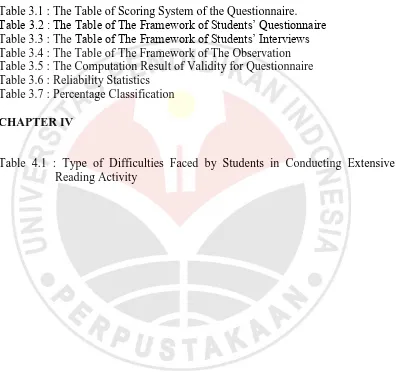LIST OF CONTENTS
STATEMENT OF AUTHORIZATION ... Error! Bookmark not defined. PREFACE ... Error! Bookmark not defined. ACKNOWLEDGEMENT ... Error! Bookmark not defined. ABSTRACT ... Error! Bookmark not defined.
LIST OF CONTENTS ... i
LIST OF FIGURES ... ivx
LIST OF TABLES ... x
LIST OF APPENDIXES ... xi
CHAPTER I: INTRODUCTION ... 1
1.1 Background of the Study ... 1
CHAPTER II: REVIEW OF RELATED LITERATURE ... 11
2.1 Extensive Reading Activity: Definition and Characteristics ... 11
Siti Rosmalina Nurhayati, 2013
Students responses to the use of extensive reading activities in learning new vocabulary Universitas Pendidikan Indonesia | repository.upi.edu
2.3 Extensive Reading Activity: Kinds of Activities ... 16
2.4 Teaching Vocabulary ... 17
2.5 Principles of Teaching and Learning Vocabulary ... 19
2.6 The Relationship between Teaching Extensive Reading and Teaching Vocabulary ... 20
2.7 Previous Studies relates to the Implementation of Extensive Reading Activities in Learning Vocabulary ... 20
CHAPTER III: RESEARCH METHODOLOGY ... 22
3.1 Research Question ... 22
3.2 Research Design ... 22
3.3 Research Subject ... 23
3.3.1 Population and Sample ... 23
3.4 Data Collection ... 23
3.4.1 Questionnaire ... 24
3.6 Establishment of Trustworthiness ... 34
CHAPTER IV: FINDINGS AND DISCUSSION ... 36
4.1 Findings ... 36
4.1.1 Students’ Responses to the Use of Extensive Reading Activities in Leaning New Vocabulary... 36
4.1.1.1 Affective Response ... 36
4.1.1.2 Purpose-Driven Response ... 41
4.2 Discussion ... 49
CHAPTER V: CONCLUSIONS AND SUGGESTIONS ... 53
5.1 Conclusions ... 53
5.2 Suggestions ... 55
5.2.1 For Teachers who are Interested in the Implementation of Extensive Reading Activities ... 55
5.2.2 For the Next Further Study ... 56
Siti Rosmalina Nurhayati, 2013
Students responses to the use of extensive reading activities in learning new vocabulary Universitas Pendidikan Indonesia | repository.upi.edu
LIST OF FIGURES
CHAPTER III
Figure 3.1 : Triangulation Method Figure
Figure 3.2 : Interactive Model by Miles and Huberman (1984)
CHAPTER IV
Figure 4.1 : Students’ Feeling whether Assignment to Read at Home or outside
the Class is a Joyful Activity
Figure 4.2 : Students’ Response whether They are Happy in Participating in a
Class or Group Discussion Related to the Text They have Read outside the Class
Figure 4.3 : Students’ Response whether Extensive Reading Activity Motivates
Students in Learning New Vocabulary.
Figure 4.4 : Students’ Response whether Extensive Reading Activity Help
Students to Learn New Vocabulary
Figure 4.5 : Students' Response whether Assignment to Read at Home/outside the Class is a Beneficial Activity
Figure 4.6 : Students’ Response whether Extensive Reading Help Students to
LIST OF TABLES
CHAPTER III
Table 3.1 : The Table of Scoring System of the Questionnaire.
Table 3.2 : The Table of The Framework of Students’ Questionnaire
Table 3.3 : The Table of The Framework of Students’ Interviews
Table 3.4 : The Table of The Framework of The Observation Table 3.5 : The Computation Result of Validity for Questionnaire Table 3.6 : Reliability Statistics
Table 3.7 : Percentage Classification
CHAPTER IV
Siti Rosmalina Nurhayati, 2013
Students responses to the use of extensive reading activities in learning new vocabulary Universitas Pendidikan Indonesia | repository.upi.edu
LIST OF APPENDIXES
Appendix 1 : Official Letters Appendix 2 : Research Instruments Appendix 3 : Data Collection Appendix 4 : Lesson Plan

